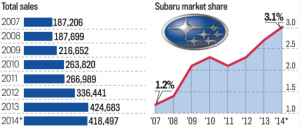Subaru’s Effective Market Entry Strategy Influences Purchasing Behavior
Often times a new product will be created for a market that already exists and has substantial levels of competition. A new product will likely receive some trouble in this situation because a main stream buyer will have a much lower reservation price for the newer and less known product. Thus, the new product will mostly appeal to more price-sensitive customers. This is a rather common occurrence that many incumbent market players will simply ignore because it doesn’t effect their large share of the main stream market. However, a strong appeal to price-sensitive customers can generate profits for product improvement and raise reservation prices. If continuously ignored, the product can eventually take some main stream market share at a low price that other competitors simply can’t provide.
An example of this overarching strategy can be clearly seen in Subaru’s entry into the American markets. Subaru’s two main entry strategies were to make more roomy interiors and to drop the average vehicle price below its Japanese competitors. The business model applies to logical buyers that need reliable cars: “The brand [has] steadfast dedication to no-nonsense vehicles designed for loyal, upscale, active buyers who pride themselves on separating what counts from what’s merely fashionable”. This no-nonsense design policy provides price sensitive customers a car that puts function before form. Another effort Subaru took to appeal to this practical model was building each one of their car models with all wheel drive. Every step Subaru has taken to break into the United States market has been a long term commitment to its true identity as a brand and has captured more and more customers along the way. For this reason Subaru is often stated to have one of the most loyal customer bases. Costumers clearly understand what they are buying when they purchase a Subaru; the values of functionality, value and safety have always been at the core of Subaru and that has convinced buyers to invest in the brand for the long-term. Therefore, Subaru’s strategy took a small market share and grew it over time through company values that raised reservation prices, and in turn generated a higher quantity demanded for its vehicles.
The results of Subaru’s strategy are quite impressive. The firm’s dedication to its core values created the sixth highest loyalty rate of all U.S. brands at 53.6%, which is significantly larger than the average of 44.9%. Furthermore, Its marketshare doubled from 2007-2013, and starting in 2007 the firm saw seven straight years of increasing sales. These statistics are pictured below:

Subaru’s market-breaking entry strategy has now created a new window of opportunity through cascading information. The nearly tripled market share has certainly been noticed around the United States. What was once a car only for quirky and outdoorsy customers has become a fairly mainstream vehicle containing values that resonate with many potential buyers. People now see Subaru’s on the road quite often, and can’t help but think that the brand is worth looking into for future purchases. Therefore, many potential buyers will partly base their purchasing decisions off of what those around them have chosen. These effects of mimicry and herding behavior within cascading information are evidently a positive consequence of Subaru’s dedication to its values. Also, the more marketshare that Subaru can capture, the stronger these effects will become. Ultimately, Subaru’s loyal customer base helped generate increased marketshare through increased reservation prices, which will further help the company’s success through the resulting impacts of information cascades in the United States.
Sources:
